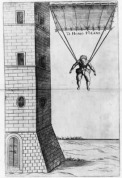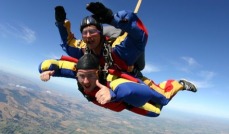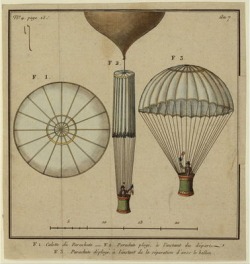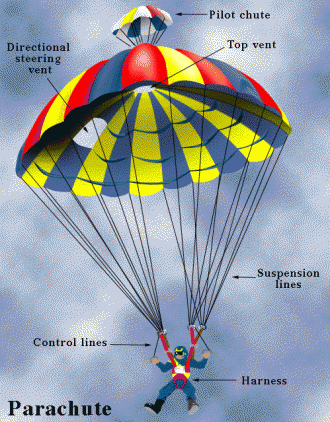The Science of Flight
Parachutes and hot Air Balloons
Parachutes
Title.

The first parachute was created in 1617 by a Fauste Veranzio modled off da Vinci's drawing. Much time passed before more development was made to the parachute. When in 1783 Joseph and Jacques Montgolfier successfully lowered animals from roof tops using the rough design. In the same year a man by the name of Sebastian Lenormand jumped from a tower using a 14 foot diameter parachute.
In 1785 Jean Pierre Blanchard started to work on a foldable silk parachute. Do to the fact most parachutes had had a riged frame and where very dificult for storing and traveling with.
In 1797, Andrew Garnerin used the first parachute without a frame. Anderew Garnerin made a jump from 8000 feet, with one of his parachutes. As he fell a man by the name of Lalandes obseved how the chute spun. He sugested cuting a hole in the top of the chute to decrease spinning. This modernly came to be known as the vent and dramatically reduces spining.
The following century parachute use stayed strictly within the relm of carnavals and dare devil acts. The opinion of the use of parachutes became very poor after Robert Cocking fell to his death in 1837. He used an inverted coneshaped parachute and through this act he was known as parachuting's first fatality.
There was many ohter adjustments made to the parachute but the next major advancement was the harness by Captain Thomas Baldwin in 1887. Another advanement and probubly the most inportant invetion was the idea of folding the parachute into a back pack of some kind. This advancement was made by Paul Letteman and Kathchen Paulus in 1890. Kathchen Paulus also came up with the idea of the parachute being able to releace the first parachute and open another if needed.
In 1785 Jean Pierre Blanchard started to work on a foldable silk parachute. Do to the fact most parachutes had had a riged frame and where very dificult for storing and traveling with.
In 1797, Andrew Garnerin used the first parachute without a frame. Anderew Garnerin made a jump from 8000 feet, with one of his parachutes. As he fell a man by the name of Lalandes obseved how the chute spun. He sugested cuting a hole in the top of the chute to decrease spinning. This modernly came to be known as the vent and dramatically reduces spining.
The following century parachute use stayed strictly within the relm of carnavals and dare devil acts. The opinion of the use of parachutes became very poor after Robert Cocking fell to his death in 1837. He used an inverted coneshaped parachute and through this act he was known as parachuting's first fatality.
There was many ohter adjustments made to the parachute but the next major advancement was the harness by Captain Thomas Baldwin in 1887. Another advanement and probubly the most inportant invetion was the idea of folding the parachute into a back pack of some kind. This advancement was made by Paul Letteman and Kathchen Paulus in 1890. Kathchen Paulus also came up with the idea of the parachute being able to releace the first parachute and open another if needed.
How Modern Parachutes Work

Drag is the push or pull on someone or something from air or water. Water has much more drag because it's alot more dence. The more surface area something has the more drag it has. In this case a parachute has a lot more drag than a human, therefore, slowing down the parachute more than it can slow down a human. A parachute is light and its broad surface captures the air when falling. A parachute works on the concept that everything that goes up, must come down. It follows this law of gravity. If it wasn't for air resistence, everything would fall at the same speed. As Neal Armstrong demonstrated for us on the moon where there is no air resistance. A rock moves the air particles apart better and more quickly than a feather because it has more mass and is heavier. On the other hand, a feather moves air particles less efficiently because the air particles get stuck in the feather and move the feather slowly due to it's light weight. A parachute is made of thin, light material such as a feather yet has a large surface through area so that when the parachute is released it captures the air particles in it. The air particles lift the parachute into the air as the fabric stretches apart. The weight of the person using the parachute is very important to the way the parachute operates. Their weight helps pull the parachute into the particles faster. This means if the object controling the parachute was light, it would not move fast enough to keep the parachute open.
parachute plunder
Parts of the Parachute
History of hot air balloons

People in ancent Greese about 2000 years ago came up with the idea of buoyancy. In the 13th century, an English scientist Roger Bacon, and a German philosopher, Albertus Magnus, both thought of flying machines based on the idea of boyancy.
On September 19, 1783, scientist Bilatre De Rozier launched the first balloon named Aerostat Rebeillion. The passengers consisted of a duck, a chicken and a sheep. The balloon stayed in the air for as long as 15 minutes before crashing to the ground.
Two months later the first man's flight was attempted on November 21 built by two French brothers Joseph and Etienne Montgolfier. The balloon flew for a total of 20 minutes after being let go from the centre of Paris. In 1785, just 2 years after the first flight, a French ballonist Jean Pierre Blanchard and his American co-pilot John Jefferies became the first to fly across the English Channel in a hot air balloon. At this time, this was considered a great feat and was known as one of the large steps in ballooning history. The next major event was on January 7, 1793 when Jean Pierre Blanchard (yes, the same Jean) was the first to fly in North America. George Washington was president at the time and was there to witness the balloon launch.
Not much changed other than slight variations in deslgn over the next 100 years. But in August , 1932, Swiss Scientist Auguste Biccard flew to a height of 52,498 feet . This set the new altitude record. Records contiued to be broken monthly through the next couple of years and the race was on to see who could reach the highest altitude.
In 1935 the altitude record was set and remained at this level for the next 20 years. The balloon Explorer 2, a gas helium model flew to the miraculous height of 72,395 feet (13.7 miles). This was of extreme importance and a huge step in ballooning history because it proved that humans could survive in a pressurized chamber at extremely high altitudes.
On September 19, 1783, scientist Bilatre De Rozier launched the first balloon named Aerostat Rebeillion. The passengers consisted of a duck, a chicken and a sheep. The balloon stayed in the air for as long as 15 minutes before crashing to the ground.
Two months later the first man's flight was attempted on November 21 built by two French brothers Joseph and Etienne Montgolfier. The balloon flew for a total of 20 minutes after being let go from the centre of Paris. In 1785, just 2 years after the first flight, a French ballonist Jean Pierre Blanchard and his American co-pilot John Jefferies became the first to fly across the English Channel in a hot air balloon. At this time, this was considered a great feat and was known as one of the large steps in ballooning history. The next major event was on January 7, 1793 when Jean Pierre Blanchard (yes, the same Jean) was the first to fly in North America. George Washington was president at the time and was there to witness the balloon launch.
Not much changed other than slight variations in deslgn over the next 100 years. But in August , 1932, Swiss Scientist Auguste Biccard flew to a height of 52,498 feet . This set the new altitude record. Records contiued to be broken monthly through the next couple of years and the race was on to see who could reach the highest altitude.
In 1935 the altitude record was set and remained at this level for the next 20 years. The balloon Explorer 2, a gas helium model flew to the miraculous height of 72,395 feet (13.7 miles). This was of extreme importance and a huge step in ballooning history because it proved that humans could survive in a pressurized chamber at extremely high altitudes.
Hot air balloons work due to the fact that hot air is less dense than cold air which makes hot air rise and lift into the air. This is why the hot air balloon rises. Hot air balloons need to be big because it takes a lot of heated air to lift a small amount of weight. For example, the ratio of hot air to weight is 5-1.
Because of gravity, air particles are drawn downward to the earth. But air pressure from being being pulled to the earth creates an upward push of air particles opposite of that pull. Gravity only has so much strength and eventually maxes out making the pressure of air particles and the pull of gravity equal. Pressure drops as you rise in altitude because as you move higher in the atmosphere, the air has less air mass above it so the balancing pressure decreases.
Basically, air pressure is greater below things than above things, so air pushes up more than it pushes down. But this pressure is weak compaired to gravity. Most solid objects are going to be heavier than the air around it. Things only become boyant when they are lighter than the air around them. So, in the example of a hot air balloon, it takes a massive amount of heat to lift the heavy balloon plus the basket hanging underneath it.
Because of gravity, air particles are drawn downward to the earth. But air pressure from being being pulled to the earth creates an upward push of air particles opposite of that pull. Gravity only has so much strength and eventually maxes out making the pressure of air particles and the pull of gravity equal. Pressure drops as you rise in altitude because as you move higher in the atmosphere, the air has less air mass above it so the balancing pressure decreases.
Basically, air pressure is greater below things than above things, so air pushes up more than it pushes down. But this pressure is weak compaired to gravity. Most solid objects are going to be heavier than the air around it. Things only become boyant when they are lighter than the air around them. So, in the example of a hot air balloon, it takes a massive amount of heat to lift the heavy balloon plus the basket hanging underneath it.
Other sources about Hot-Air Balloons
http://www.hot-airballoons.com/cybride.html
http://www.hotairballoons.com/hotairballoon-air-science.asp
SOURCES
Paragraph.http://www.parachutehistory.com/eng/drs.html
http ://www.buzzle.com/articles/how-does-a-parachute-work.htmlhttp://www.ehow.com/how-does_4564095_a-parachute-work.html
http://www.buzzle.com/articles/how-does-a-parachute-work.html
http://www.eballoon.org/history/history-of-ballooning.html
http://www.howstuffworks.com/hot-air-balloon.htm
Paragraph.http://www.parachutehistory.com/eng/drs.html
http ://www.buzzle.com/articles/how-does-a-parachute-work.htmlhttp://www.ehow.com/how-does_4564095_a-parachute-work.html
http://www.buzzle.com/articles/how-does-a-parachute-work.html
http://www.eballoon.org/history/history-of-ballooning.html
http://www.howstuffworks.com/hot-air-balloon.htm







